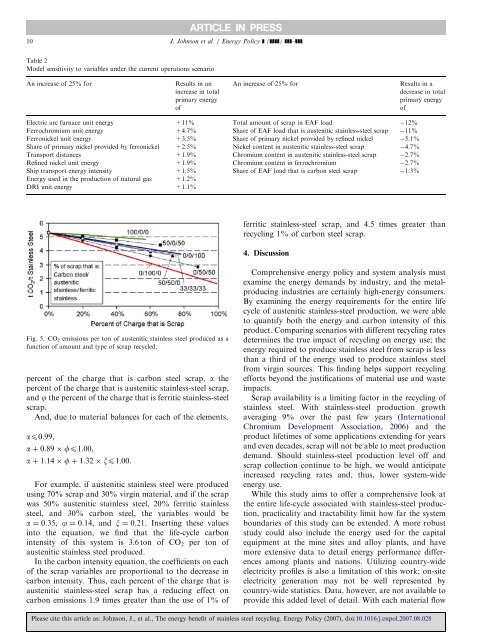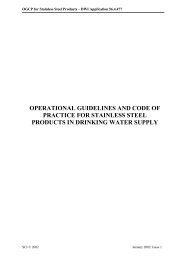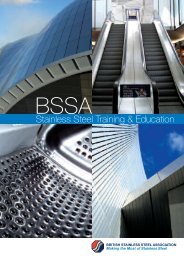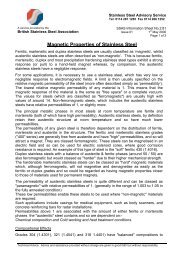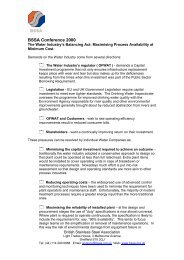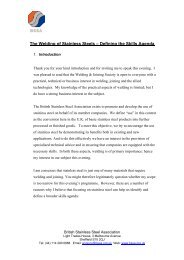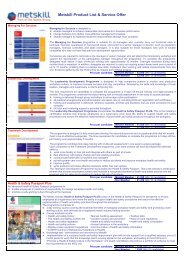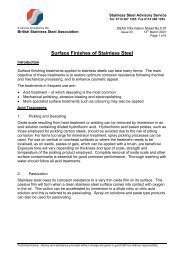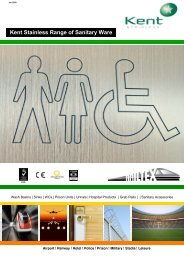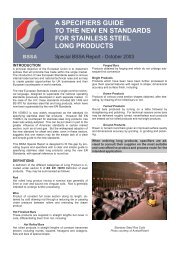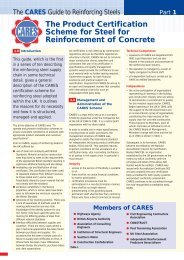The energy benefit of stainless steel recycling - British Stainless ...
The energy benefit of stainless steel recycling - British Stainless ...
The energy benefit of stainless steel recycling - British Stainless ...
You also want an ePaper? Increase the reach of your titles
YUMPU automatically turns print PDFs into web optimized ePapers that Google loves.
10<br />
ARTICLE IN PRESS<br />
J. Johnson et al. / Energy Policy ] (]]]]) ]]]–]]]<br />
Table 2<br />
Model sensitivity to variables under the current operations scenario<br />
An increase <strong>of</strong> 25% for<br />
Results in an<br />
increase in total<br />
primary <strong>energy</strong><br />
<strong>of</strong><br />
An increase <strong>of</strong> 25% for<br />
Results in a<br />
decrease in total<br />
primary <strong>energy</strong><br />
<strong>of</strong><br />
Electric arc furnace unit <strong>energy</strong> +11% Total amount <strong>of</strong> scrap in EAF load 12%<br />
Ferrochromium unit <strong>energy</strong> +4.7% Share <strong>of</strong> EAF load that is austenitic <strong>stainless</strong>-<strong>steel</strong> scrap 11%<br />
Ferronickel unit <strong>energy</strong> +3.5% Share <strong>of</strong> primary nickel provided by refined nickel 5.1%<br />
Share <strong>of</strong> primary nickel provided by ferronickel +2.5% Nickel content in austenitic <strong>stainless</strong>-<strong>steel</strong> scrap 4.7%<br />
Transport distances +1.9% Chromium content in austenitic <strong>stainless</strong>-<strong>steel</strong> scrap 2.7%<br />
Refined nickel unit <strong>energy</strong> +1.9% Chromium content in ferrochromium 2.7%<br />
Ship transport <strong>energy</strong> intensity +1.5% Share <strong>of</strong> EAF load that is carbon <strong>steel</strong> scrap 1.3%<br />
Energy used in the production <strong>of</strong> natural gas +1.2%<br />
DRI unit <strong>energy</strong> +1.1%<br />
ferritic <strong>stainless</strong>-<strong>steel</strong> scrap, and 4.5 times greater than<br />
<strong>recycling</strong> 1% <strong>of</strong> carbon <strong>steel</strong> scrap.<br />
4. Discussion<br />
Fig. 5. CO 2 emissions per ton <strong>of</strong> austenitic <strong>stainless</strong> <strong>steel</strong> produced as a<br />
function <strong>of</strong> amount and type <strong>of</strong> scrap recycled.<br />
percent <strong>of</strong> the charge that is carbon <strong>steel</strong> scrap, a the<br />
percent <strong>of</strong> the charge that is austenitic <strong>stainless</strong>-<strong>steel</strong> scrap,<br />
and j the percent <strong>of</strong> the charge that is ferritic <strong>stainless</strong>-<strong>steel</strong><br />
scrap.<br />
And, due to material balances for each <strong>of</strong> the elements,<br />
ap0:99,<br />
a þ 0:89 fp1:00,<br />
a þ 1:14 f þ 1:32 xp1:00.<br />
For example, if austenitic <strong>stainless</strong> <strong>steel</strong> were produced<br />
using 70% scrap and 30% virgin material, and if the scrap<br />
was 50% austenitic <strong>stainless</strong> <strong>steel</strong>, 20% ferritic <strong>stainless</strong><br />
<strong>steel</strong>, and 30% carbon <strong>steel</strong>, the variables would be<br />
a ¼ 0.35, j ¼ 0.14, and x ¼ 0.21. Inserting these values<br />
into the equation, we find that the life-cycle carbon<br />
intensity <strong>of</strong> this system is 3.6 ton <strong>of</strong> CO 2 per ton <strong>of</strong><br />
austenitic <strong>stainless</strong> <strong>steel</strong> produced.<br />
In the carbon intensity equation, the coefficients on each<br />
<strong>of</strong> the scrap variables are proportional to the decrease in<br />
carbon intensity. Thus, each percent <strong>of</strong> the charge that is<br />
austenitic <strong>stainless</strong>-<strong>steel</strong> scrap has a reducing effect on<br />
carbon emissions 1.9 times greater than the use <strong>of</strong> 1% <strong>of</strong><br />
Comprehensive <strong>energy</strong> policy and system analysis must<br />
examine the <strong>energy</strong> demands by industry, and the metalproducing<br />
industries are certainly high-<strong>energy</strong> consumers.<br />
By examining the <strong>energy</strong> requirements for the entire life<br />
cycle <strong>of</strong> austenitic <strong>stainless</strong>-<strong>steel</strong> production, we were able<br />
to quantify both the <strong>energy</strong> and carbon intensity <strong>of</strong> this<br />
product. Comparing scenarios with different <strong>recycling</strong> rates<br />
determines the true impact <strong>of</strong> <strong>recycling</strong> on <strong>energy</strong> use; the<br />
<strong>energy</strong> required to produce <strong>stainless</strong> <strong>steel</strong> from scrap is less<br />
than a third <strong>of</strong> the <strong>energy</strong> used to produce <strong>stainless</strong> <strong>steel</strong><br />
from virgin sources. This finding helps support <strong>recycling</strong><br />
efforts beyond the justifications <strong>of</strong> material use and waste<br />
impacts.<br />
Scrap availability is a limiting factor in the <strong>recycling</strong> <strong>of</strong><br />
<strong>stainless</strong> <strong>steel</strong>. With <strong>stainless</strong>-<strong>steel</strong> production growth<br />
averaging 9% over the past few years (International<br />
Chromium Development Association, 2006) and the<br />
product lifetimes <strong>of</strong> some applications extending for years<br />
and even decades, scrap will not be able to meet production<br />
demand. Should <strong>stainless</strong>-<strong>steel</strong> production level <strong>of</strong>f and<br />
scrap collection continue to be high, we would anticipate<br />
increased <strong>recycling</strong> rates and, thus, lower system-wide<br />
<strong>energy</strong> use.<br />
While this study aims to <strong>of</strong>fer a comprehensive look at<br />
the entire life-cycle associated with <strong>stainless</strong>-<strong>steel</strong> production,<br />
practicality and tractability limit how far the system<br />
boundaries <strong>of</strong> this study can be extended. A more robust<br />
study could also include the <strong>energy</strong> used for the capital<br />
equipment at the mine sites and alloy plants, and have<br />
more extensive data to detail <strong>energy</strong> performance differences<br />
among plants and nations. Utilizing country-wide<br />
electricity pr<strong>of</strong>iles is also a limitation <strong>of</strong> this work; on-site<br />
electricity generation may not be well represented by<br />
country-wide statistics. Data, however, are not available to<br />
provide this added level <strong>of</strong> detail. With each material flow<br />
Please cite this article as: Johnson, J., et al., <strong>The</strong> <strong>energy</strong> <strong>benefit</strong> <strong>of</strong> <strong>stainless</strong> <strong>steel</strong> <strong>recycling</strong>. Energy Policy (2007), doi:10.1016/j.enpol.2007.08.028


